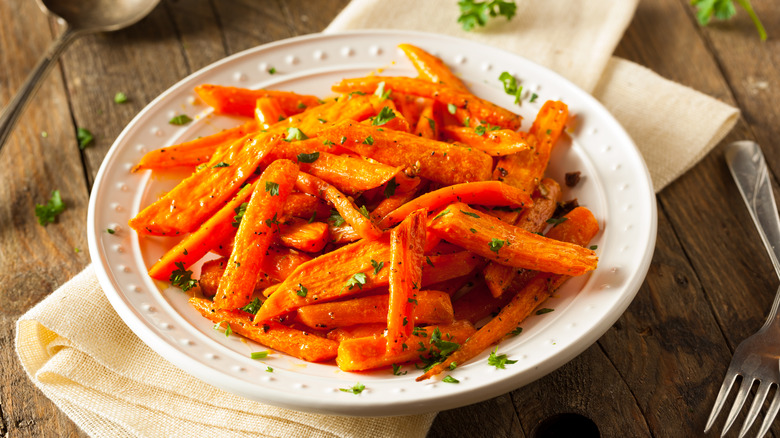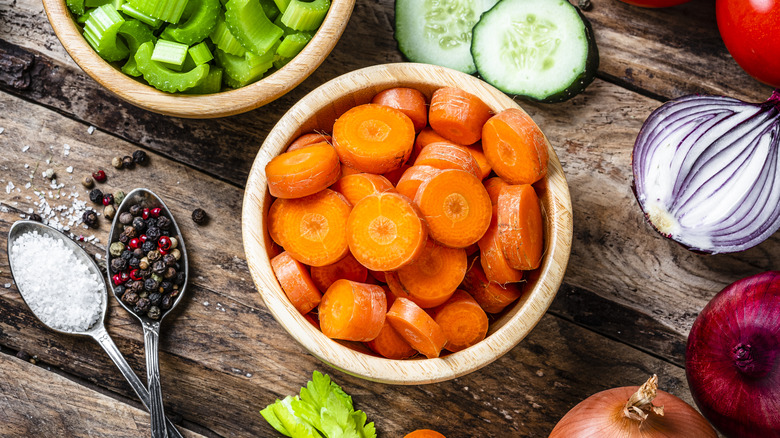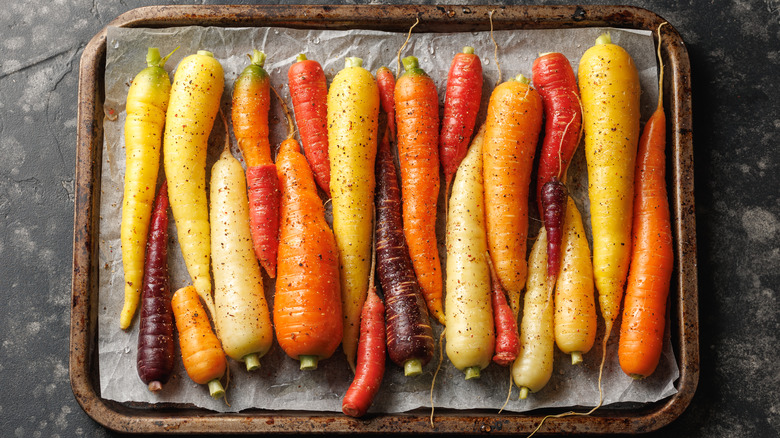If You Want Your Carrots To Cook Faster, Use This Method
There are plenty of tips for cooking carrots, and many ways to prepare them, too — whether for a creamy Mexican carrot soup, whipping up a traditional Sunday roast, or making honey-glazed carrots to complement your Thanksgiving feast. You can roast them for a deep, concentrated sweetness, saute them for a crisp texture, or steam and boil them for a super soft and tender consistency. But which method cooks them the fastest? To find out, Food Republic spoke with Gaurav Chawla, executive chef of Farzi in New York City, who recommends combining steaming and sauteing for quick and delicious results.
"Place carrots in a pan with a splash of water, butter or oil, and season with salt," Chawla told us. "The water steams the carrots for about three to five minutes." Steaming is an ideal method to preserve the many nutrients in the carrots while cooking them to a tender but not mushy consistency, which can happen when they are boiled for too long.
However, one pretty big downside to steaming is that it doesn't produce the most flavorful results, and that's where sauteing comes in handy. Once the water has evaporated, "the carrots finish cooking by being sauteed in the fat for flavor and [a] glossy appearance." This develops a delicious char on the outside and is much faster than roasting, which can take up to 45 minutes to finish.
How cutting shape affects cooking time
Any carrot connoisseur will know that these crunchy treats can be cooked in countless different shapes, and everybody's got a favorite style. There are classic French-bistro styles like thick batons, to thinly sliced julienne, or the very thinly diced brunoise. Then there are the cylindrical diagonally sliced carrots, or the coin shape which can also be turned into playful shapes like stars or hearts to win over even the most veggie-averse kids. But when it comes to how quickly the carrots cook, their shape can actually make a big difference.
"The surface area and thickness matter more than shape," Gaurav Chawla told us. Both of these factors determine how much heat is transferred to the carrots, so the more surface area there is means that more of the carrot is exposed to the pan, while the thickness determines how quickly this heat penetrates all the way through the carrot. This means that carrots with high surface area and minimal thickness will cook the quickest. "Matchsticks (or julienne) are the fastest to cook, about two to three minutes," he explained. "Thin diagonal slices are the next fastest ... they take about three to four minutes to cook." Naturally, bulky, thick shapes will cook for longer, with thickly sliced coins or batons taking "eight to 12 minutes," Chawla explained. No matter what the shape is, they should be sliced to the same size and thickness to ensure that they cook evenly and uniformly.
Certain carrot varieties cook faster than others
Carrots are incredibly diverse, featuring over 150 different varieties. If asked to picture a carrot, you'll probably think of the Imperator, which are the long and slender ones that you'll find on grocery store shelves or served at restaurants. Then there are the shorter, stump-shaped varieties like Nantes or Chantenay, or the aesthetically pleasing heirloom carrots which come in a wide spectrum of colors and shapes. Then you've got the young, bite-size immature carrots which are irresistibly snackable. While all are delicious, the variety you choose can have a big impact on how long it takes to cook.
"Younger carrots will cook faster, while older and larger carrots are more fibrous and therefore take longer to cook," Gaurav Chawla told us. "They have higher moisture content and less lignin, which provides rigid structural support to plant tissues as plants grow." Also, baby carrots are usually sold with the hard, protective outer layer removed, which allows the heat to penetrate them much more easily when steaming.
"Nantes and Chantenay carrots are tender, sweet, and medium-fast cooking, while Imperator carrots ... take longer to cook due to denser core," he added. "Heirloom purple or black carrots can be sometimes firmer and slightly slower to cook." However, cutting any carrot into smaller, uniform pieces speeds up the process and allows whatever variety you choose to cook more evenly.



